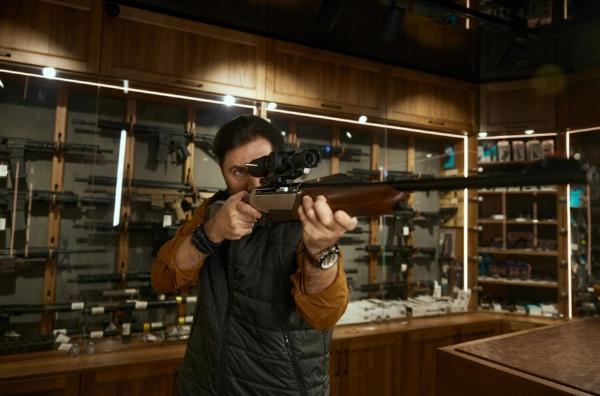How to Select the Perfect Optics for Long-Range Shooting

Strong 8k brings an ultra-HD IPTV experience to your living room and your pocket.
Long-range shooting is an art form that demands precision, patience, and the right equipment. Central to your success on the range or in the field is the optic you choose to mount on your rifle. With the right scope or binoculars, hitting targets at extreme distances becomes a calculated science rather than a game of chance. This article will guide you through the key considerations when selecting the perfect optics for long-range shooting, ensuring your investment is tailored to your specific needs and shooting style.
Understanding the Basics of Optics for Long-Range Shooting
Before diving into the nuances of selecting an optic, it’s important to understand the fundamental types of optics available:
1. Rifle Scopes
Rifle scopes are the most common optics used in long-range shooting. They offer varying levels of magnification, clarity, and reticle designs to help shooters zero in on their targets. Scopes are generally divided into two categories based on focal planes: first focal plane (FFP) and second focal plane (SFP).
2. Binoculars
While not mounted directly on your rifle, binoculars play a crucial role in spotting targets and assessing the environment. High-quality binoculars can make the difference between a successful shot and a missed opportunity, especially in hunting scenarios where observation is key.
3. Spotting Scopes
These are high-magnification, single-eye scopes often mounted on tripods. They allow shooters to observe distant targets with great detail, making them invaluable for spotting hits and misses, especially in competitive shooting.
Key Factors to Consider When Selecting an Optic
Choosing the right optic involves a thorough assessment of several factors, each of which can significantly impact your shooting experience and success.
1. Magnification Power
Magnification is often the first feature shooters consider when selecting an optic. For long-range shooting, the ability to zoom in on distant targets is crucial. However, more magnification isn’t always better.
Low Magnification (3-9x): Ideal for shooting at shorter ranges (100-300 yards), common in hunting scenarios where quick target acquisition is needed.
Medium Magnification (10-15x): Offers a balance between field of view and target detail, suitable for mid-range shooting (300-600 yards).
High Magnification (16-25x or higher): Best for extreme long-range shooting (600 yards and beyond), where pinpoint accuracy is required.
Tip: Consider the environment where you’ll be shooting. For instance, hunting in dense woods might require a lower magnification to quickly find and track a moving target, whereas shooting across open plains might benefit from higher magnification.
2. Reticle Types
The reticle, or crosshair, inside the scope is another critical factor. Different reticle designs offer various advantages depending on your shooting style.
Duplex Reticle: A simple design with thicker outer lines that thin out towards the center. It’s versatile and suitable for most shooting scenarios.
Mil-Dot Reticle: Popular among military and tactical shooters, this reticle features dots along the crosshairs to help estimate range and bullet drop.
BDC (Bullet Drop Compensator) Reticle: Designed to help shooters compensate for bullet drop at various distances. This is particularly useful for long-range shooters who need to make quick adjustments based on distance.
MOA/MRAD Reticle: These reticles are preferred by precision shooters for their fine measurements, allowing for precise adjustments in minute increments.
According to a survey by the National Shooting Sports Foundation, over 40% of precision shooters prefer using Mil-Dot reticles due to their versatility in various shooting conditions. This statistic highlights the importance of choosing a reticle that matches your specific needs.
3. Durability
Long-range shooting often takes place in challenging environments, from dusty deserts to rain-soaked forests. Your optic needs to withstand these conditions without losing zero or compromising on clarity.
Weatherproofing: Ensure your scope is waterproof, fog-proof, and shockproof. These features are non-negotiable for maintaining performance in adverse weather conditions.
Material Construction: Look for scopes made from aircraft-grade aluminum or other durable materials. This ensures the optic can withstand the recoil of powerful calibers and rough handling.
For example, scopes from reputable brands like Vortex Optics and Leupold are known for their rugged construction and lifetime warranties, offering peace of mind to shooters who demand reliability.
4. Optical Clarity
The quality of the glass and the coatings used on the lenses directly impact the clarity and brightness of your image. High-quality optics reduce glare, improve light transmission, and provide a sharp image even in low-light conditions.
Coated Lenses: Fully multi-coated lenses are the standard for high-end optics, providing the best performance in terms of light transmission and color accuracy.
Objective Lens Size: A larger objective lens (50mm or more) can gather more light, offering a brighter image, especially in dim conditions. However, it also adds weight and bulk to the scope.
5. First Focal Plane (FFP) vs. Second Focal Plane (SFP)
Understanding the difference between FFP and SFP scopes is crucial for long-range shooters. The choice between the two depends on how you plan to use the reticle.
FFP Scopes: In these scopes, the reticle scales with the zoom level. This means that the reticle’s size changes as you adjust magnification, making holdovers and range estimation accurate at any magnification. This feature is especially useful in dynamic shooting scenarios where targets vary in distance.
SFP Scopes: Here, the reticle remains the same size regardless of magnification. SFP scopes are often preferred by hunters and shooters who operate at a fixed or limited range, where the consistency of the reticle size is an advantage.
According to industry reports, approximately 30% of long-range shooters prefer FFP scopes for their adaptability in various shooting situations, underscoring the importance of this feature in your selection process.
6. Price and Budget Considerations
Optics for long-range shooting can vary widely in price, from a few hundred to several thousand dollars. While it’s tempting to go for the most expensive option, it’s important to balance quality with affordability.
Entry-Level ($300-$700): These scopes offer good quality for beginners or those on a budget. They typically have basic features and are suitable for recreational shooting or hunting at moderate distances.
Mid-Range ($700-$1500): In this category, you’ll find scopes with better glass quality, more durable construction, and additional features like illuminated reticles or zero-stop turrets.
High-End ($1500+): Premium scopes in this range offer exceptional clarity, advanced reticle options, and robust construction. They’re designed for serious long-range shooters who demand the best performance.
7. Brand Reputation
Reputation matters when selecting an optic, as it often reflects the quality and reliability of the product. Established brands like Nightforce, Swarovski, and Schmidt & Bender are revered in the long-range shooting community for their precision, durability, and innovation.
Customer Reviews: Reading reviews from other long-range shooters can provide valuable insights into how a particular scope performs in real-world conditions.
Warranty: A strong warranty is a good indicator of a manufacturer’s confidence in their product. Brands that offer lifetime warranties, such as Leupold and Vortex, are often favored by shooters for their commitment to customer satisfaction.
Tailoring Your Optic to Your Shooting Style
Ultimately, the best optic for long-range shooting is one that aligns with your specific shooting style and needs. Here are some scenarios to consider:
1. Precision Target Shooting
For those who enjoy the challenge of hitting small targets at extreme distances, a high-magnification FFP scope with a fine reticle (like MOA or MRAD) is ideal. These scopes allow for precise adjustments and clear target identification, even at ranges beyond 1000 yards.
2. Hunting
Hunters often need a scope that balances magnification with a wide field of view, enabling quick target acquisition and tracking. A mid-magnification SFP scope with a BDC reticle might be the best choice, providing the flexibility to adjust for different distances without losing sight of the target.
3. Tactical Shooting
Tactical shooters require durability and versatility in their optics. An FFP scope with a Mil-Dot or similar reticle, combined with weatherproofing and robust construction, ensures reliability in varied and challenging environments.
Conclusion
Selecting the perfect optic for long-range shooting is a process that requires careful consideration of your specific needs, shooting style, and the environment in which you’ll be shooting. By understanding the key factors such as magnification, reticle type, durability, and brand reputation, you can make an informed decision that enhances your shooting experience and accuracy.
Remember, the right optic is an investment not just in equipment, but in your overall success and enjoyment of long-range shooting. Whether you’re hitting targets at 1000 yards or stalking game in the backcountry, the right scope can make all the difference. Take the time to research, test, and choose an optic that matches your goals, and you’ll be well on your way to mastering the art of long-range shooting.
Note: IndiBlogHub features both user-submitted and editorial content. We do not verify third-party contributions. Read our Disclaimer and Privacy Policyfor details.




